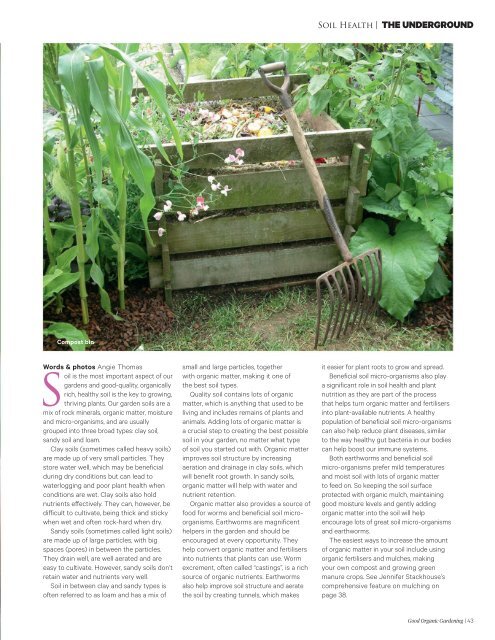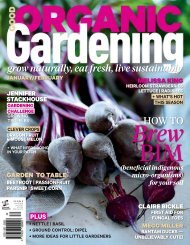3. Good Organic Gardening - May-June 2016 AvxHome.in
3. Good Organic Gardening - May-June 2016 AvxHome.in
3. Good Organic Gardening - May-June 2016 AvxHome.in
Create successful ePaper yourself
Turn your PDF publications into a flip-book with our unique Google optimized e-Paper software.
Soil Health | THE UNDERGROUND<br />
Compost b<strong>in</strong><br />
Words & photos Angie Thomas<br />
Soil is the most important aspect of our<br />
gardens and good-quality, organically<br />
rich, healthy soil is the key to grow<strong>in</strong>g,<br />
thriv<strong>in</strong>g plants. Our garden soils are a<br />
mix of rock m<strong>in</strong>erals, organic matter, moisture<br />
and micro-organisms, and are usually<br />
grouped <strong>in</strong>to three broad types: clay soil,<br />
sandy soil and loam.<br />
Clay soils (sometimes called heavy soils)<br />
are made up of very small particles. They<br />
store water well, which may be beneficial<br />
dur<strong>in</strong>g dry conditions but can lead to<br />
waterlogg<strong>in</strong>g and poor plant health when<br />
conditions are wet. Clay soils also hold<br />
nutrients effectively. They can, however, be<br />
difficult to cultivate, be<strong>in</strong>g thick and sticky<br />
when wet and often rock-hard when dry.<br />
Sandy soils (sometimes called light soils)<br />
are made up of large particles, with big<br />
spaces (pores) <strong>in</strong> between the particles.<br />
They dra<strong>in</strong> well, are well aerated and are<br />
easy to cultivate. However, sandy soils don’t<br />
reta<strong>in</strong> water and nutrients very well.<br />
Soil <strong>in</strong> between clay and sandy types is<br />
often referred to as loam and has a mix of<br />
small and large particles, together<br />
with organic matter, mak<strong>in</strong>g it one of<br />
the best soil types.<br />
Quality soil conta<strong>in</strong>s lots of organic<br />
matter, which is anyth<strong>in</strong>g that used to be<br />
liv<strong>in</strong>g and <strong>in</strong>cludes rema<strong>in</strong>s of plants and<br />
animals. Add<strong>in</strong>g lots of organic matter is<br />
a crucial step to creat<strong>in</strong>g the best possible<br />
soil <strong>in</strong> your garden, no matter what type<br />
of soil you started out with. <strong>Organic</strong> matter<br />
improves soil structure by <strong>in</strong>creas<strong>in</strong>g<br />
aeration and dra<strong>in</strong>age <strong>in</strong> clay soils, which<br />
will benefit root growth. In sandy soils,<br />
organic matter will help with water and<br />
nutrient retention.<br />
<strong>Organic</strong> matter also provides a source of<br />
food for worms and beneficial soil microorganisms.<br />
Earthworms are magnificent<br />
helpers <strong>in</strong> the garden and should be<br />
encouraged at every opportunity. They<br />
help convert organic matter and fertilisers<br />
<strong>in</strong>to nutrients that plants can use. Worm<br />
excrement, often called “cast<strong>in</strong>gs”, is a rich<br />
source of organic nutrients. Earthworms<br />
also help improve soil structure and aerate<br />
the soil by creat<strong>in</strong>g tunnels, which makes<br />
it easier for plant roots to grow and spread.<br />
Beneficial soil micro-organisms also play<br />
a significant role <strong>in</strong> soil health and plant<br />
nutrition as they are part of the process<br />
that helps turn organic matter and fertilisers<br />
<strong>in</strong>to plant-available nutrients. A healthy<br />
population of beneficial soil micro-organisms<br />
can also help reduce plant diseases, similar<br />
to the way healthy gut bacteria <strong>in</strong> our bodies<br />
can help boost our immune systems.<br />
Both earthworms and beneficial soil<br />
micro-organisms prefer mild temperatures<br />
and moist soil with lots of organic matter<br />
to feed on. So keep<strong>in</strong>g the soil surface<br />
protected with organic mulch, ma<strong>in</strong>ta<strong>in</strong><strong>in</strong>g<br />
good moisture levels and gently add<strong>in</strong>g<br />
organic matter <strong>in</strong>to the soil will help<br />
encourage lots of great soil micro-organisms<br />
and earthworms.<br />
The easiest ways to <strong>in</strong>crease the amount<br />
of organic matter <strong>in</strong> your soil <strong>in</strong>clude us<strong>in</strong>g<br />
organic fertilisers and mulches, mak<strong>in</strong>g<br />
your own compost and grow<strong>in</strong>g green<br />
manure crops. See Jennifer Stackhouse’s<br />
comprehensive feature on mulch<strong>in</strong>g on<br />
page 38.<br />
<strong>Good</strong> <strong>Organic</strong> <strong>Garden<strong>in</strong>g</strong> | 43
















